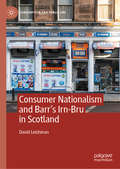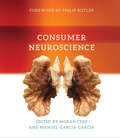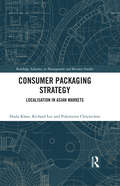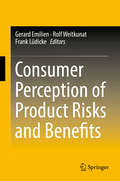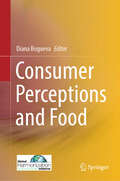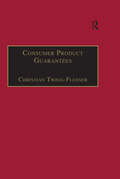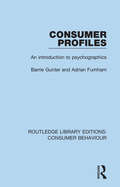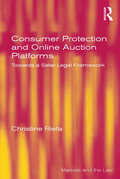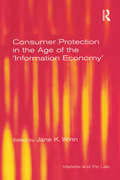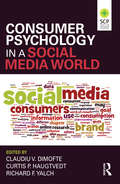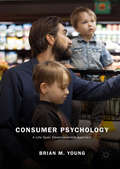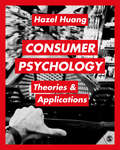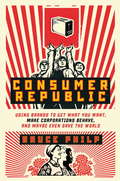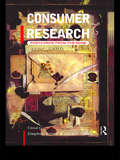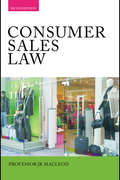- Table View
- List View
Consumer Lending in France and America
by Gunnar TrumbullWhy did America embrace consumer credit over the course of the twentieth century, when most other countries did not? How did American policy makers by the late twentieth century come to believe that more credit would make even poor families better off? This book traces the historical emergence of modern consumer lending in America and France. If Americans were profligate in their borrowing, the French were correspondingly frugal. Comparison of the two countries reveals that America's love affair with credit was not primarily the consequence of its culture of consumption, as many writers have observed, nor directly a consequences of its less generous welfare state. It emerged instead from evolving coalitions between fledgling consumer lenders seeking to make their business socially acceptable and a range of non-governmental groups working to promote public welfare, labor, and minority rights. In France, where a similar coalition did not emerge, consumer credit continued to be perceived as economically regressive and socially risky.
Consumer Math
by Larry D. Lemon Larry L. HallPrepare your students for making financial decisions with instruction about credit card charges, taxes, interest on loans and savings, personal banking, and costs of transportation, food, clothing, utilities, insurance, and filling out income tax forms. Being a good steward of the Lord's money is the primary emphasis. The student text presents concepts with numerous examples and step-by-step explanations. Each section contains five cumulative review problems, and each chapter contains a chapter review.
Consumer Mathematics
by Kathleen M. HarmeyerThis book on Consumer Mathematics will be very useful for day-to-day dealings. The chapters included are: Earning Money, Buying Food, Shopping for Clothes, Managing a Household, Buying and Maintaining a Car, Working with Food, Improving your Home, Traveling, Budgeting your Money, Banking and Investing, Paying Taxes, and Preparing for Careers
Consumer Nationalism and Barr’s Irn-Bru in Scotland: Iron Nation (Consumption and Public Life)
by David LeishmanThis book connects a detailed analysis of Irn-Bru’s brand identity over time to theories of national identity, consumer studies, and banal nationalism. It situates the commercial history of Barr’s Irn-Bru in a transnational context and shows how Irn-Bru has become a symbol of Scotland through processes of rewriting, reframing and institutionalized forgetting, linking the consumption of what began as a trans-national generic product to a specific national community. As such, Leishman presents a longitudinal, cross-disciplinary approach to analysing branding and advertising as multi-modal forms of discourse, in order to underline the role of commercial, non-state actors and popular consumerism in the phenomenon of banal nationalism. It will be of interest to students and scholars researching nationalism, consumption, and Scottish studies.
Consumer Neuroscience (The\mit Press Ser.)
by Moran Cerf Manuel Garcia-GarciaA comprehensive introduction to using the tools and techniques of neuroscience to understand how consumers make decisions about purchasing goods and services.Contrary to the assumptions of economists, consumers are not always rational actors who make decisions in their own best interests. The new field of behavioral economics draws on the insights of psychology to study non-rational decision making. The newer field of consumer neuroscience draws on the findings, tools, and techniques of neuroscience to understand how consumers make judgments and decisions. This book is the first comprehensive treatment of consumer neuroscience, suitable for classroom use or as a reference for business and marketing practitioners.After an overview of the field, the text offers the background on the brain and physiological systems necessary for understanding how they work in the context of decision making and reviews the sensory and perceptual mechanisms that govern our perception and experience. Chapters by experts in the field investigate tools for studying the brain, including fMRI, EEG, eye-tracking, and biometrics, and their possible use in marketing. The book examines the relation of attention, memory, and emotion to consumer behavior; cognitive factors in decision making; and the brain's reward system. It describes how consumers develop implicit associations with a brand, perceptions of pricing, and how consumer neuroscience can encourage healthy behaviors. Finally, the book considers ethical issues raised by the application of neuroscience tools to marketing.ContributorsFabio Babiloni, Davide Baldo, David Brandt, Moran Cerf, Yuping Chen, Patrizia Cherubino, Kimberly Rose Clark, Maria Cordero-Merecuana, William A. Cunningham, Manuel Garcia-Garcia, Ming Hsu, Ana Iorga, Philip Kotler, Carl Marci, Hans Melo, Kai-Markus Müller, Brendan Murray, Ingrid L. C. Nieuwenhuis, Graham Page, Hirak Parikh, Dante M. Pirouz, Martin Reimann, Neal J. Roese, Irit Shapira-Lichter, Daniela Somarriba, Julia Trabulsi, Arianna Trettel, Giovanni Vecchiato, Thalia Vrantsidis, Sarah Walker
Consumer Packaging Strategy: Localisation in Asian Markets (Routledge Advances in Management and Business Studies)
by Richard Lee Huda Khan Polymeros ChrysochouThe consumer packaged goods (CPG) industry is dominated by major Western brands. The dominance of such major brands extends to Asian burgeoning markets. These conglomerates often rely on packaging as a strategic tool to entice Asian consumers. This book illustrates how packaging as a marketing tool is more than simply changing the label or translating the brand into vernacular language. It examines how different packaging elements (e.g. information, imagery, packaging type) can help to communicate product values to Asian consumers. Drawing upon rich knowledge of the Asian CPG markets with extensive findings from fieldworks in the key Asian markets, this book explains how Western brands are localising their packaging design in Asian markets. It provides invaluable insight into how major Western CPG brands have relied heavily on their packaging strategies to compete not only against domestic brands but also against other foreign brands. The book includes in-depth interviews with brand managers of several major Western CPG brands and retailers, and sheds light on emerging trends of CPG packaging in Asia.
Consumer Payment Systems - Japan
by Andrei Hagiu Benjamin EdelmanIn 2008, the Japanese consumer payments landscape featured ongoing widespread use of cash, limited use of credit cards and rapid rise of e-money systems based on contactless technology embedded in cards and especially mobile phones. The case details the alliances that created new products, as well as the regulations that sometimes stood in the way. Throughout, the case identifies incentives for both consumers and merchants, including direct costs, efficiency benefits, rebates, and treatment in case of loss or fraud.
Consumer Payment Systems - United States
by Andrei Hagiu Benjamin EdelmanIn 2008, the US consumer payments landscape was characterized by the ongoing prevalence of credit and debit card networks, the decline of checks, the rise of stored value cards, and the growth of new payment methods such as PayPal, Bill Me Later and decoupled debit. This case presents the structure of these payment methods, focusing on incentives for both consumers and merchants, including direct costs, efficiency benefits, rebates, and treatment in case of loss or fraud.
Consumer Perception of Product Risks and Benefits
by Gerard Emilien Rolf Weitkunat Frank LüdickeThis book reflects the current thinking and research on how consumers' perception of product risks and benefits affects their behavior. It provides the scientific, regulatory and industrial research community with a conceptual and methodological reference point for studies on consumer behavior and marketing. The contributions address various aspects of consumer psychology and behavior, risk perception and communication, marketing research strategies, as well as consumer product regulation. The book is divided into 4 parts: Product risks; Perception of product risks and benefits; Consumer behavi∨ Regulation and responsibility.
Consumer Perceptions and Food
by Diana BoguevaThis book is a timely overview of the various aspects of consumer perception related to food. This book explores consumer perceptions that are vital to marketers and often underlie the success or failure of products in the marketplace. Perception is the process of selecting, organizing, and interpreting sensations into a meaningful whole, and this book highlights how human perceptions are unique, highly subjective, and easily distorted. These perceptions are influenced by our senses—sight, hearing, taste, smell, and touch—as well as our beliefs, emotions, opinions, and experiences. This book states that this is related to food, and perceptions are also guided by beliefs, thoughts, emotions, feelings, and opinions about, or preferences, expectations, and knowledge of, and the sensory experience, the fear, and the relationships built between the consumers and the food over time. This book aims to further the understanding of the fundamental mechanisms which determine individual responses to existing and emerging food issues. This book provides insights into consumer behaviour (e.g. consumer decision making, promoting behaviour change), factors influencing consumers’ food and meal choices, confidence in the safety of food, perception of health-related messages and food laws and regulations, sustainable and responsible consumer behaviour (e.g. food waste), acceptability of new food alternatives, innovations and technologies, integrating consumer insight and communication challenges in cross-functional communications in innovation processes. "Consumer Perceptions and Food" delves into how these perceptions shape consumer behavior, from decision-making and behavior change to meal choices and confidence in food safety. It explores the impact of health-related messages, food laws, and regulations, and examines the acceptability of new food alternatives and technologies. The book also addresses the importance of sustainable and responsible consumer behavior, including food waste and ethical consumption. Through a rich array of insights, this book provides a deep understanding of the fundamental mechanisms that drive individual responses to food issues. It emphasizes the importance of mindful eating—making conscious food choices that benefit our health, the environment, and the planet. This involves considering the origins of our food, its production methods, and the broader impacts of our choices on public health and ecosystems. This book is a call to action for consumers to rethink their relationship with food, fostering deeper connections and appreciation for sustainable practices and ethical consumption. It is a crucial step in the ongoing journey of shaping the future of food, guided by informed and mindful consumers.
Consumer Politics in Postwar Japan: The Institutional Boundaries of Citizen Activism
by Maclachlan Patricia L.This book examines Japan's postwar consumer protection movement, which, organized largely by housewives, led to the passage of basic consumer protection legislation in 1968. Macmillan points to the importance of activity at the local level, the role of minority parties, the limited utility of the courts, and the place of lawyers and academics in providing access to power.
Consumer Politics in Postwar Japan: The Institutional Boundaries of Citizen Activism (Studies Of The East Asian Institute (coup) Ser.)
by Patricia MaclachlanProviding comparisons to the United States and Britain, this book examines Japan's postwar consumer protection movement. Organized largely by and for housewives and spurred by major cases of price gouging and product contamination, the movement led to the passage of basic consumer protection legislation in 1968. Although much of the story concerns the famous "iron triangle" of big business, national bureaucrats, and conservative party politics, Maclachlan takes a broader perspective. She points to the importance of activity at the local level, the role of minority parties, the limited utility of the courts, and the place of lawyers and academics in providing access to power. These mild social strategies have resulted in a significant amount of consumer protection.
Consumer Product Guarantees
by Christian Twigg-FlesnerThis book presents a detailed analysis of the function of consumer product guarantees and the related legal issues. It applies research findings from the fields of consumer complaining behaviour, marketing science and economics to the legal context. Its central argument is that guarantees could be one way of assisting consumers in resolving product quality disputes. Consumers tend to seek to resolve such disputes informally by complaining, rather than by seeking to go through the courts or structured forms of alternative dispute resolution. Such complaints can be supported by encouraging reliance on consumer product guarantees, particularly where consumers also enjoy strong legal rights. With this in mind, the book develops a legal framework for consumer guarantees, which is based on two key principles: fairness and transparency. There then follows an analysis of English and EC provisions on guarantees, as well as of relevant US law. Particular consideration is given to the relationship between consumer guarantees and statutory rights.
Consumer Profiles: An introduction to psychographics (Routledge Library Editions: Consumer Behaviour)
by Adrian Furnham Barrie GunterPsychographics have been developed in the field of market research as a way to relate consumer behaviour to market choice. This book, originally published in 1992, introduces the essential elements of psychographics. It shows how researchers go about defining consumer profiles and designing successful research programmes. It looks at the way they are applied in various consumer groups and uses case study material to focus on some specific products from cameras to pet food.
Consumer Protection Law: Legal Policy And Consumer Protection (Markets and the Law)
by Stephen Weatherill Geraint HowellsThis fully revised and updated second edition of Consumer Protection Law introduces the reader to the substantive law of consumer protection in the United Kingdom, the emphasis being on the place of United Kingdom law within an evolving European legal system and also on the need to draw upon comparative experience. The book not only seeks to place consumer protection in its purely black-letter context but also draws upon wider readings to show that consumer protection law is a complex area of law which reflects and shapes the individual citizen's position within the modern economy.
Consumer Protection and Online Auction Platforms: Towards a Safer Legal Framework (Markets and the Law)
by Christine RiefaOnline auctions have undergone many transformations and continue to attract millions of customers worldwide. However these popular platforms remain understudied by legal scholars and misunderstood by legislators. This book explores the legal classification of online auction sites across a range of countries in Europe. Including empirical studies conducted on 28 online auction websites in the UK, the research focusses on the protection of consumers’ economic rights and highlights the shortcomings that the law struggles to control. With examinations into important developments, including the Consumer Rights Directive and the latest case law from the CJEU on the liability of intermediaries, Riefa anticipates changes in the law, and points out further changes that are needed to create a safe legal environment for consumers, whilst preserving the varied business model adopted by online auction sites. The study provides insights into how technical measures as well as a tighter legislative framework or enforcement pattern could provide consumers with better protection, in turn reinforcing trust, and ultimately benefiting the online auction platforms themselves.
Consumer Protection in the Age of the 'Information Economy' (Markets And The Law Ser.)
by Jane K. WinnTo date, there have been few theoretical inquiries into the relationship between the technological innovation and basic objectives of consumer protection laws. This book addresses this need by considering the impact of technological innovation on the foundations of consumer advocacy, contracting behaviour, control over intellectual capital and information privacy. The collection presents a unique and timely perspective on these issues. The authors, internationally renowned experts, from diverse areas such as consumer issues in technology markets, contract, and intellectual property provide a fresh perspective on these topics. Contributions provide novel approaches to the question of what consumer protection might consist of in the context of technological innovation. The book will be a valuable resource to academics and researchers in law and public policy and is easily accessible to graduate and undergraduate students working in these areas.
Consumer Psychology in a Social Media World
by Curtis P. Haugtvedt Claudiu V. Dimofte Richard F. YalchConsumer Psychology in a Social Media World seeks to illustrate the relevance of consumer psychology theory and research to understanding the social media world that has rapidly become a key component in the social and economic lives of most individuals. Despite the rapid and widespread adoption of social media by consumers, research focused on individuals’ use thereof and its implications for organizations and society has been limited and published in scattered outlets. This has made it difficult for those trying to get either a quick introduction or an in-depth understanding of the associated issues to locate relevant scientific-based information. The book is organized into five broad sections. The first presents a summary overview of social media, including a historical and cultural perspective. The second section is focused on social media as a modern form of word of mouth, always considered the most impactful on consumers. It also touches upon a motivational explanation for why social media has such a strong and broad appeal. Section three addresses the impact that consumers’ switch to social media as a preferred channel has had on marketers’ branding and promotional efforts, as well as the ways in which consumer involvement can be maintained through this process. Section four takes a methodological perspective on the topic of social media, assessing ways in which big data and consumer research are influenced by novel ways of gathering consumer feedback and gauging consumer sentiment. Finally, section five looks at some consumer welfare and public policy implications, including privacy and disadvantaged consumer concerns. Consumer Psychology in a Social Media World will appeal to those who are involved in creating, managing, and evaluating products used in social media communications. As seen in recent financial and business market successes (e.g., Facebook, Twitter, LinkedIn, Instagram, Pinterest, WhatsApp, etc.), businesses focused on facilitating social media are part of the fastest growing and most valuable sector of today’s economy.
Consumer Psychology: A Life Span Developmental Approach
by Brian M. YoungThis book approaches consumer psychology from a unique perspective - it covers the entire lifespan, from birth to old age. Childhood and youth are not discussed as areas special, different and remote from the rest of consumer research but are integrated into our development as humans. Consumption is viewed as a process by groups and individuals with the cycle continuing through to disposal or ownership and possession. The author discusses how people’s natural lifespan influences their relationship to the things they own, how preferences are developed from childhood and how motivations for purchases change throughout their lives from childhood to old age. This book brings together the most recent findings and theories on child and youth consumption, including children’s understanding of advertising and marketing, teen and youth identities and their consumption tastes. Moving through Erikson’s life stages chapters continue on to adulthood, the mid-life ‘crisis’ and possessions and ownership in older consumers. This is a deeply interdisciplinary work that will be of interest to scholars across the fields of psychology, business and marketing, as well as to the more general consumer.
Consumer Psychology: Theories & Applications
by Hazel HuangConsumer Psychology: Theories and Applications is the first textbook that systematically discusses a wide range of the psychological theories and their applications in consumer behaviour in an accessible style. The selected psychological theories include both classic theories and contemporary developments, and the applications in consumer behaviour draw from state-of-the-art research underpinned by theories and practical implications. Why are influencers with a smaller number of followers sometimes more effective than the mega influencers? Why are the sounds of brands, such as Coca-Cola and Kit Kat, attractive to consumers? How does music, scent, or lighting influence shoppers? Why can using consumption to boost self-esteem be negative to consumer well-being? Readers will explore these questions and more. This textbook is essential reading for advanced marketing students and also applied psychology students looking at the business world. It includes a chapter on research methods in consumer psychology and can also provide a vital guide for those completing a dissertation project in consumer psychology. Hazel Huang is a Chartered Marketer of the Chartered Institute of Marketing and an Assistant Professor in Marketing at Durham University Business School, UK.
Consumer Psychology: Theories & Applications
by Hazel HuangConsumer Psychology: Theories and Applications is the first textbook that systematically discusses a wide range of the psychological theories and their applications in consumer behaviour in an accessible style. The selected psychological theories include both classic theories and contemporary developments, and the applications in consumer behaviour draw from state-of-the-art research underpinned by theories and practical implications. Why are influencers with a smaller number of followers sometimes more effective than the mega influencers? Why are the sounds of brands, such as Coca-Cola and Kit Kat, attractive to consumers? How does music, scent, or lighting influence shoppers? Why can using consumption to boost self-esteem be negative to consumer well-being? Readers will explore these questions and more. This textbook is essential reading for advanced marketing students and also applied psychology students looking at the business world. It includes a chapter on research methods in consumer psychology and can also provide a vital guide for those completing a dissertation project in consumer psychology. Hazel Huang is a Chartered Marketer of the Chartered Institute of Marketing and an Assistant Professor in Marketing at Durham University Business School, UK.
Consumer Reaction, Food Production and the Fukushima Disaster: Assessing Reputation Damage Due to Potential Radiation Contamination
by Kentaka ArugaThis book examines the factors involved in consumer responses to food produced in regions near the Fukushima Daiichi Nuclear Plant following the March 2011 Eastern Japanese earthquake, and assesses how responses to reports on food safety and risk of radiation contamination shaped consumer perceptions of and subsequent behavior toward products from the Fukushima prefecture. On the basis of a survey conducted in 2014 among 8,000 consumers from all parts of Japan and focusing on ten food products (rice, cucumbers, apples, shiitake mushrooms, beef, pork, eggs, tuna fish, wakame seaweed, and mineral water) it investigates consumer choices specifically based on rumor ("fuyou") and not fact as well as how "fuyou" damage shaped such choices. It then goes on to analyze the differences between these customer choices.
Consumer Republic
by Bruce PhilpConsumer Republic dares you to consider this: The power to save the world lies with the consumer. The foundation of Bruce Philp's message is this single, inarguable truth: Brands make corporations accountable. They are the only leverage the average consumer has with which to make a company behave itself. Expensive to create, essential to making money, and more public than anything else a corporation has or does, a brand is an enormously valuable and fragile asset to them. And we consumers have the power to make it worthless. As someone who has worked on the inside, Philp knows exactly how this power can be made to work for us. Through this book he will inspire you to make every dollar you spend count. To buy less, maybe, but demand better. To make better choices. And then to speak up when you're happy and when you're not. Pin every one of these acts to a brand, Consumer Republic promises, and corporations will be forced to cooperate in making our way of life sustainable. Abandon brands, and we'll surrender the marketplace to scoundrels. Take control of them, and we can save the world.From the Hardcover edition.
Consumer Research: Postcards From the Edge (Consumer Research And Policy Ser.)
by Stephen Brown Darach TurleyConsumer Research: Postcards from the Edge is a collection of cutting-edge essays by leading exponents of postmodern consumer research from Europe and America. Topics covered include: * chronicle, composition and fabulation in consumer research * postmodern approaches to pluralism in consumer research * marketing in cyberspace * poststructuralism in marketing * semiotics in marketing and consumer research
Consumer Sales Law: The Law Relating to Consumer Sales and Financing of Goods
by James Devenney John MacleodFully updated and revised, this comprehensive and informative textbook provides readers with an overview of current consumer sales law and equips them with a view of how this fast-changing subject has, and will continue to develop through the inclusion of new reform proposals. This book analyzes the interaction of consumer sales law with politics, the appeal of consumer protection to politicians and the influence of the European Union and the EU Directives. It also discusses the removal of consumer sales law from its traditional realm of legal professionals to consumer and debt advisors and public officials with the power to seek injunctions to protect consumers. In addition to this, it: fully integrates both the Unfair Commercial Practices Directive 2005 and the Consumer Credit Act 2006 into the basic 1974 Act explains how the sale of Goods Act 1979 has been modified by the 1999 Directive combines the public protection of consumers under the Enterprise Act 2002 (e.g. Office of Fair Trading) is supplemented by comprehensive e-updates on its Companion Website, keeping the content current between editions. Written by an author with forty years experience of teaching sales and finance law to undergraduates, this textbook is an essential tool for all undergraduates studying commercial and consumer sales law.

